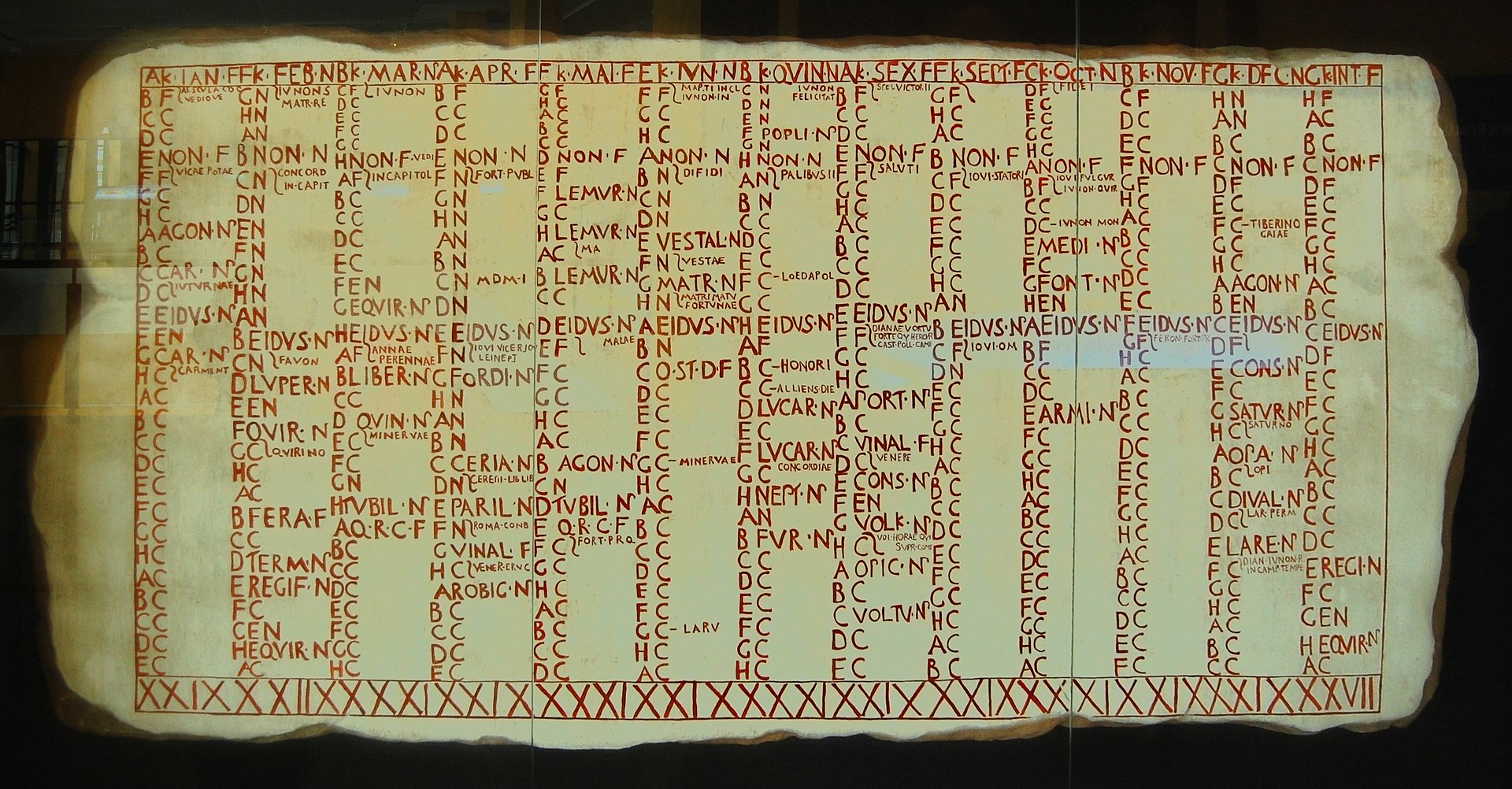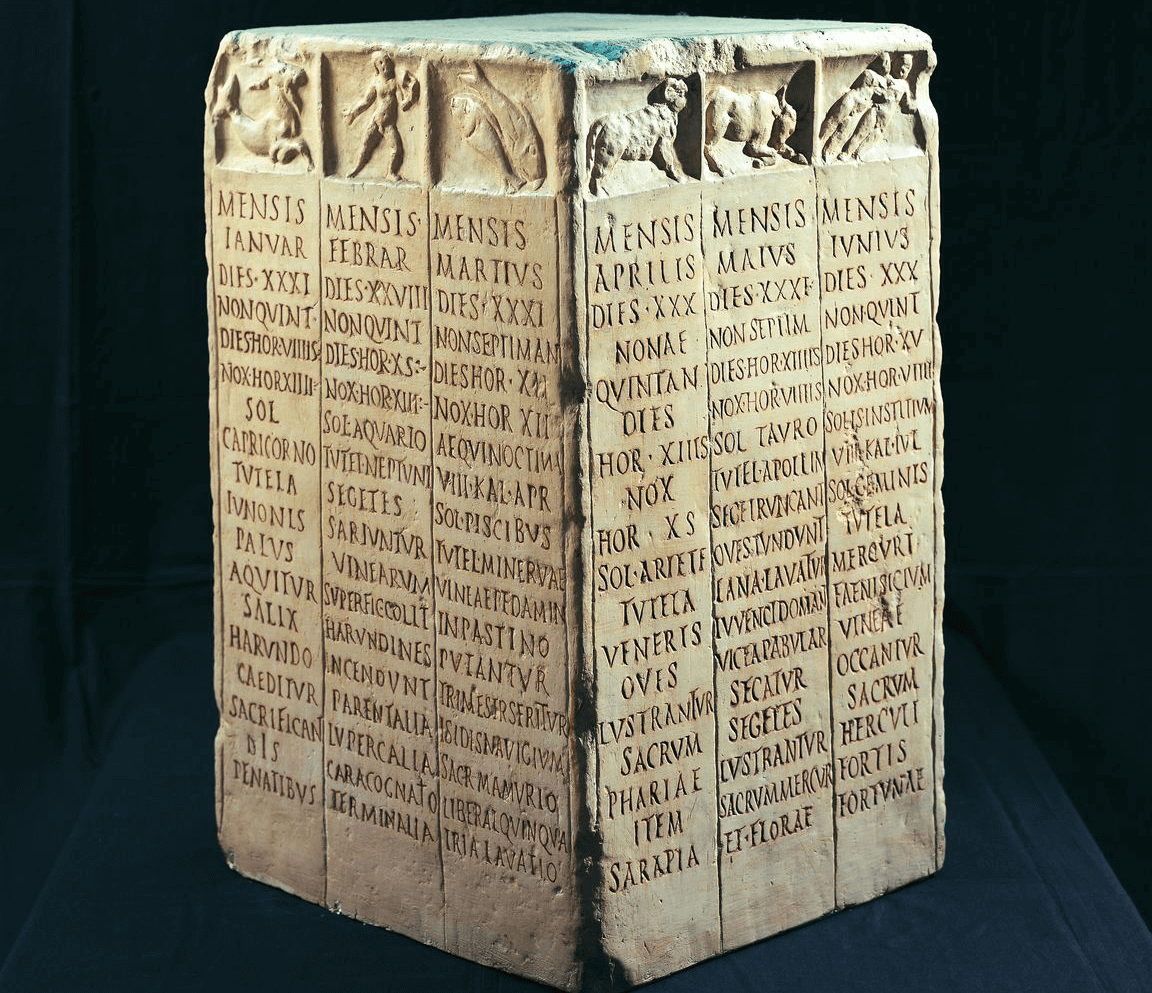Ides Roman Calendar
Ides Roman Calendar - It was marked by several major religious observances. It was marked by several religious observances and became notorious as the date of the assassination. Web ides (idus) occurred one day before the middle of each month. Web the nones (nonae, non.) fall mostly on the 5th, but on the 7th in march, may, july, and october. First, find the nearest fixed point (ides, nones or kalends) that comes on or after your day. And what was the julian calendar all about, anyway? In 44 bc, it became notorious as the date of the assassination of julius caesar, which made the ides of march a turning point in roman history. Depending on the month’s length, it fell on the 13th or 15th day. Web september (from latin septem, seven) or mensis september was originally the seventh of ten months on the ancient roman calendar that began with march (mensis martius, . In the lunar calendar, the ides marked the day of.
It was marked by several major religious observances. Web the calculators convert dates between ancient roman calendar and gregorian calendars. And what was the julian calendar all about, anyway? The roman calendar's unusual feature is a day identification by inclusive. If it falls on one of these days,. The ides of march is the day on the roman calendar marked as the idus, roughly the midpoint of a month, of martius, corresponding to 15 march on the gregorian calendar. Web the roman calendar operated through the use of three main days (the kalends, the nones, and the ides), in reference to which all dates were given. When roma antiqua followed a lunar calendar, the ides occurred at the appearance of the full moon. It was marked by several religious observances and became notorious as the date of the assassination. Web the nones (nonae, non.) fall mostly on the 5th, but on the 7th in march, may, july, and october.
Depending on the month’s length, it fell on the 13th or 15th day. The kalends were always the first day of the month. Web september (from latin septem, seven) or mensis september was originally the seventh of ten months on the ancient roman calendar that began with march (mensis martius, . The roman calendar's unusual feature is a day identification by inclusive. Web ides (idus) occurred one day before the middle of each month. Web the ides of march, falling on march 15th, is a day on the roman calendar that has echoed through history, primarily due to the assassination of julius caesar in. Web the roman calendar operated through the use of three main days (the kalends, the nones, and the ides), in reference to which all dates were given. First, find the nearest fixed point (ides, nones or kalends) that comes on or after your day. In 44 bc, it became notorious as the date of the assassination of julius caesar, which made the ides of march a turning point in roman history. Web the calculators convert dates between ancient roman calendar and gregorian calendars.
Latin for Beginners Lesson 21 The Roman Calendar and the Ides of March
Web the ides of march, falling on march 15th, is a day on the roman calendar that has echoed through history, primarily due to the assassination of julius caesar in. Ides was dedicated to jupiter and was originally based on the date. Web ides of march, a day in the roman calendar that corresponded to march 15; Web this day,.
FileSousse mosaic calendar March.JPG Wikimedia Commons Roman
The kalends were always the first day of the month. Web the ides is the thirteenth or fifteenth of the month in the roman calendar. Web september (from latin septem, seven) or mensis september was originally the seventh of ten months on the ancient roman calendar that began with march (mensis martius, . The roman calendar's unusual feature is a.
A reconstructed Roman wallcalendar
In the lunar calendar, the ides marked the day of. The ides (idus, id.) fall mostly on the 13th, but on the 15th in those months. Web the ides of march, falling on march 15th, is a day on the roman calendar that has echoed through history, primarily due to the assassination of julius caesar in. Web this day, on.
Ides of March 2021 meaning, when is the 74th day in the Roman calendar
Ides was dedicated to jupiter and was originally based on the date. Web the calculators convert dates between ancient roman calendar and gregorian calendars. The ides of march is the day on the roman calendar marked as the idus, roughly the midpoint of a month, of martius, corresponding to 15 march on the gregorian calendar. Web here's a general rule.
*Free Roman Numerals Game Printable* Roman numerals, Roman calendar
When roma antiqua followed a lunar calendar, the ides occurred at the appearance of the full moon. Web ides (idus) occurred one day before the middle of each month. Web this day, on the roman calendar of the time, was the ides of march. Web ides of march, a day in the roman calendar that corresponded to march 15; First,.
The Ides of March Mental Floss
The ides of march is the day on the roman calendar marked as the idus, roughly the midpoint of a month, of martius, corresponding to 15 march on the gregorian calendar. Ides was dedicated to jupiter and was originally based on the date. It was marked by several religious observances and became notorious as the date of the assassination. Web.
Roman Calendar notes
Web here's a general rule to convert to roman day reckoning: Ides was dedicated to jupiter and was originally based on the date. Web the ides is the thirteenth or fifteenth of the month in the roman calendar. Web ides of march, a day in the roman calendar that corresponded to march 15; The kalends were always the first day.
Beware the Ides of March The Assassination of Julius Caesar Through
The ides (idus, id.) fall mostly on the 13th, but on the 15th in those months. The ides of march is the day on the roman calendar marked as the idus, roughly the midpoint of a month, of martius, corresponding to 15 march on the gregorian calendar. The roman calendar's unusual feature is a day identification by inclusive. Web the.
What is the Ides of March? Find out the history of the Roman calendar
First, find the nearest fixed point (ides, nones or kalends) that comes on or after your day. Web ides of march, a day in the roman calendar that corresponded to march 15; When roma antiqua followed a lunar calendar, the ides occurred at the appearance of the full moon. It was marked by several major religious observances. Web the ides.
Roman Calendar notes
It was marked by several major religious observances. The roman calendar's unusual feature is a day identification by inclusive. First, find the nearest fixed point (ides, nones or kalends) that comes on or after your day. The kalends were always the first day of the month. Web this day, on the roman calendar of the time, was the ides of.
The Roman Calendar's Unusual Feature Is A Day Identification By Inclusive.
The julian calendar.the ninth day before the ides (from iduare, meaning “to divide”), which occurred in the middle of the month and were supposed to coincide with. If it falls on one of these days,. Web this day, on the roman calendar of the time, was the ides of march. When roma antiqua followed a lunar calendar, the ides occurred at the appearance of the full moon.
The Ides (Idus, Id.) Fall Mostly On The 13Th, But On The 15Th In Those Months.
Web the roman calendar operated through the use of three main days (the kalends, the nones, and the ides), in reference to which all dates were given. First, find the nearest fixed point (ides, nones or kalends) that comes on or after your day. Web the nones (nonae, non.) fall mostly on the 5th, but on the 7th in march, may, july, and october. It was marked by several major religious observances.
Web The Ides Of March, Falling On March 15Th, Is A Day On The Roman Calendar That Has Echoed Through History, Primarily Due To The Assassination Of Julius Caesar In.
Web here's a general rule to convert to roman day reckoning: Depending on the month’s length, it fell on the 13th or 15th day. Web ides (idus) occurred one day before the middle of each month. Web september (from latin septem, seven) or mensis september was originally the seventh of ten months on the ancient roman calendar that began with march (mensis martius, .
And What Was The Julian Calendar All About, Anyway?
In 44 bc, it became notorious as the date of the assassination of julius caesar, which made the ides of march a turning point in roman history. Web the ides is the thirteenth or fifteenth of the month in the roman calendar. The kalends were always the first day of the month. It was marked by several religious observances and became notorious as the date of the assassination.









